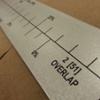Marking Stainless with CO2 & Fibermark Lasers
When it comes to laser marking stainless steel, there are two great ways to do it. These two ways are similar at the start - they both require the use of a laser and they make a permanent mark on the metal. However, beyond the start they travel different avenues to get to the finished product. For the sake of this blog I will refer to the two methods as CO2 and Fibermark.
The CO2 Laser System and Laser Bonding
The best way to describe how our lasers work is to compare the system to your printer. Using similar technology, we take the images you typically print to paper, but instead we fire a CO2 laser beam that
engraves your design. For metals, parts can be permanently marked with high contrast, high resolution marks for logos, bar-coding, identification and serialization purposes, without damage to the substrate. The marking process generally comprises three steps: 1. Application of the marking material 2. Bonding of the marking material with a laser. 3. Removal of excess, unbonded material. The resulting marking is fused to the substrate, and in most cases it is as durable as the substrate itself.
Markings placed on stainless steel are extremely durable and have survived such testing as abrasion resistance, chemical resistance, outdoor exposure, extreme heat, extreme cold, acids, bases and various organic solvents. The laser bonding process is outlined and specified in both military and marking specifications and standards. Laser bonding is also a preferred technique for use in the United States Department of Defense "Item Unique Identification" system. The CO2 laser gives you a surface marking that has a nice black contrast - easily read.
FiberMark Laser System and Laser Engraving
The FiberMark Laser is the world’s first flying-optic design incorporating a fiber laser source. Operating at a wavelength of 1062 nanometers, the FiberMark Laser etches directly into metal and marks a wide variety of materials with a simple interface that allows you to print to the laser. The FiberMark’s fiber laser source generates a laser beam by pumping intense diode light into the ends of fiber optic cables that have been doped with ytterbium. The energy from the diode light is absorbed by the ytterbium in the fiber optic cables and the energy is released in the form of photons that travel down the optic cables, creating the laser beam. With a wavelength of 1062 nm, the laser is ideal for etching directly into metal, as well as creating polished and annealed marks.
You can see the FiberMark laser in action marking a company logo on the popular Yeti Rambler in this video. Fibermarking Stainless actually cuts into the metal, giving you slight depth, which can be increased with more passes. It is a permanent mark that will last forever.
In summary, we can mark stainless steel with a permanent mark in a timely manner more than one way. It depends on what you are needing. Our friendly staff will listen to what you are trying to do and offer you the best process for the best solution.
We have two new lasers on order that will arrive within the next few weeks. I will be sharing more soon on the addititonal services and capabilities this new equipment will provide. EIH will continue to stay on the leading edge of technology so we can better serve our customer's needs.
If you have a topic that you would like covered in one of our blogs please let me know. Just put a comment below with a description of your topic and then make sure and watch for it. Until next time, enjoy your friends and family...










